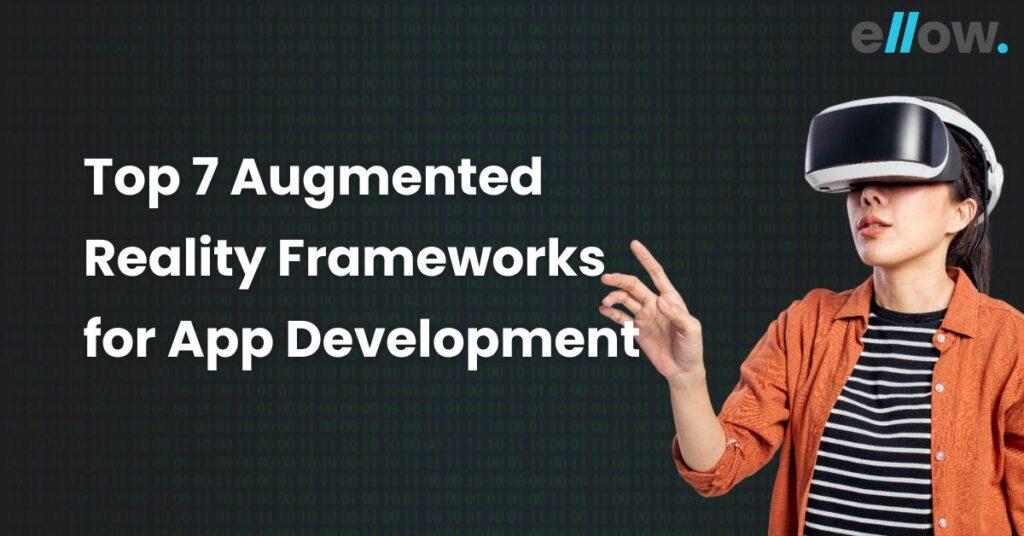
Let’s build the future together.
Great ideas need great people. Partner with us to bring your vision to life, or take the first step in your career by joining our team of innovators.

Augmented Reality (AR) has revolutionized the app development landscape, transforming how we engage with digital content. By seamlessly blending virtual elements into the real world, AR elevates our experiences and unlocks many possibilities across diverse industries.
This article will delve into AR, its frameworks, and its impact on various sectors.
The statistics say that by 2024, there will be an estimated 1.7 billion mobile augmented reality (AR) user devices worldwide.
AR blends virtual objects with the real world, providing users with enhanced and interactive experiences. Unlike Virtual Reality (VR), which creates entirely immersive digital environments, AR supplements our physical surroundings with virtual elements.
AR can be widely used in gaming, entertainment, education, healthcare, retail, and manufacturing applications.
From games that overlay virtual characters onto real environments to educational apps that bring historical artifacts to life, AR has enhanced user engagement and immersion.
Additionally, industries like architecture and interior design have adopted AR to visualize and present their concepts to clients more interactively and realistically.
To develop AR applications, developers rely on augmented reality frameworks. These frameworks handle complex tasks such as tracking the real world, recognizing objects or images, and rendering virtual elements seamlessly.
Kudan is an AR framework known for its robust tracking capabilities and versatile features. It offers both marker-based and marker-less tracking. Kudan stands out with its SLAM (Simultaneous Localization and Mapping) technology, enabling precise positioning of virtual objects in the real world.
This framework is ideal for gaming, education, and industrial training applications. However, it might lack some advanced features found in other frameworks.
Let’s see some areas where Kudan is in use:
ARKit, developed by Apple, is a powerful framework exclusively for iOS devices. It offers motion tracking, object recognition, and face tracking. ARKit integrates with RealityKit, and creates a framework for creating 3D content, providing developers with advanced rendering capabilities and realistic simulations.
Here are some popular uses of Apple’s ARKit & RealityKit:
ARCore is a software development kit (SDK) developed by Google that enables developers to create augmented reality experiences for Android devices. Released in 2017, ARCore swiftly gained traction due to its powerful capabilities and ease of use.
By leveraging the device’s sensors, camera, and processing power, ARCore allows virtual content to be seamlessly integrated into the user’s real-world environment.
This technology is used across various sectors, including gaming, education, retail, and architecture.
Vuforia is a versatile AR platform that supports marker-based and markerless tracking. It provides developers with tools for object recognition, virtual buttons, and occlusion, allowing virtual objects to interact with the real world seamlessly.
Vuforia’s compatibility with popular development tools like Unity and Unreal Engine makes it a preferred choice for AR app developers.:
Unreal Engine is a powerful game engine that offers built-in AR development capabilities. Developers can create high-quality and immersive AR experiences. The Engine provides advanced features such as realistic physics simulations, complex lighting, and 3D model integration.
Unreal Engine’s flexibility and scalability make it suitable for creating AR apps across multiple platforms.:
AR.js is an open-source JavaScript library that allows developers to create AR experiences directly by web browsers. With AR.js, users can access AR content without installing additional applications.
This framework supports marker-based and markerless tracking and is compatible with various devices and browsers. AR.js simplifies web-based AR development and enables widespread accessibility.
Wikitude SDK is a widely used AR software development kit that provides marker-based and markerless tracking, image recognition, and 3D model rendering tools. It offers a user-friendly interface and supports iOS, Android, and Windows platforms. Wikitude SDK’s simplicity and flexibility make it a popular choice for developers looking to create AR applications quickly.
The framework enables developers to easily detect and track markers in the user’s environment, such as QR codes or custom-designed markers. This functionality allows for precise positioning and alignment of virtual content onto real-world objects, enhancing the realism and immersion of AR experiences.
In conclusion, Augmented Reality has emerged as a game-changing technology in app development, revolutionizing user experiences across industries. With the right AR framework, developers can leverage the power of AR to create immersive and interactive applications.
Whether you choose Kudan, Apple’s ARKit & RealityKit, Google’s ARCore, Vuforia, Unreal Engine, AR.js, or Wikitude SDK, selecting the appropriate framework is crucial for delivering exceptional AR experiences to users.
Great ideas need great people. Partner with us to bring your vision to life, or take the first step in your career by joining our team of innovators.
Looking to build your career in development? team@ellow.io